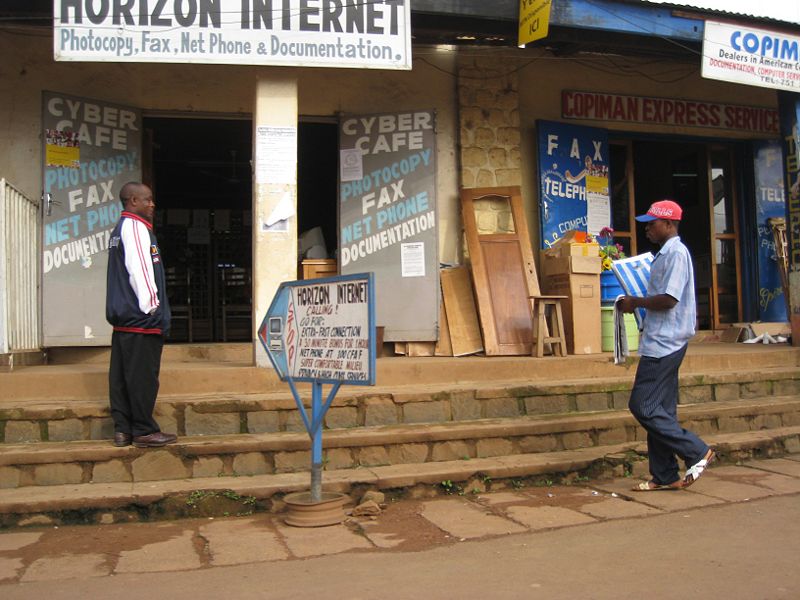Cameroon
 Cameroon is a Central African country that stretches from Lake Chad in the north to the Atlantic ocean in the west and covers an area of total 475,442 square kilometres. It is home to at least 23 million Cameroonians.
Cameroon is a Central African country that stretches from Lake Chad in the north to the Atlantic ocean in the west and covers an area of total 475,442 square kilometres. It is home to at least 23 million Cameroonians.
Location
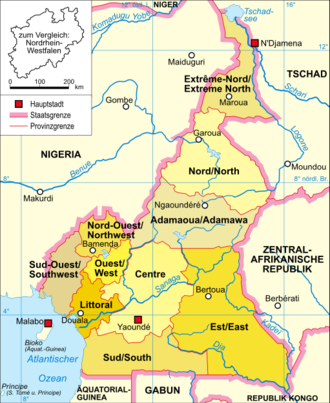
(c) wikicommons
Cameroon is situated in Central Africa and has a beautiful coast line at the Atlantic. It extends from the dry savannas around the Chad lake in the tropical rainforests of central Africa and up to the Atlantic ocean. Cameroon thus has all the landscape features of its neighbouring countries Nigeria, Chad, Central African Republic, The Republic of the Congo, Gabon and Equatorial Guinea. The first portugese explorers who found the Cameroon, found lots of prawns in a river and gave it the name Camarões. Since then Cameroon is known as the “Prawn Country”.
Landscape
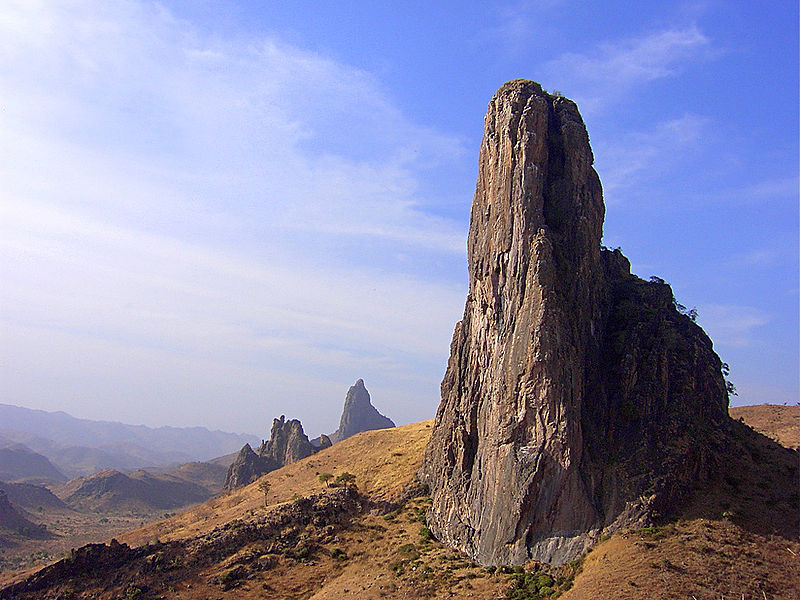
(c) Acaja
Cameroon is located between Nigeria in the west and Chad and the Central African Republic in the east. In the south, Cameroon is bordered by Equatorial Guinea, Gabun and the Republic of Congo. It is near to the equator and is a country made up of many tropical forests and lakes.
In the outermost north is Lake Chad. The climate there is hot and dry. There is very little rain and the peoples and animals suffer frequently from droughts. The inland is characterised by a high plain, where there are lots of volcanoes and secret lakes. The highland of Cameroon offers a change from the Savannas of the north and the rainforest of the south. Volcanic mountains stretch to the coast in the West, including the highest mountain in west-Africa, the Cameroon Mountain. This hilly region is one of the rainiest areas in the world. The equatorial climate here averages around 25 ° Celsius.
Yaoundé, Cameroon’s Capital
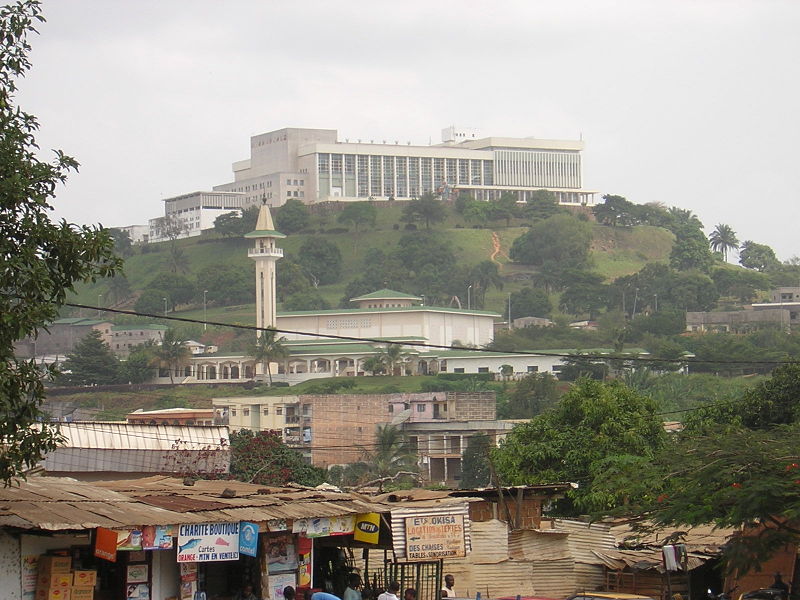 Yaoundé is the capital of Cameroon, situated in the southern part of the country. It is known as the city of seven hills, because it is dramatically spread over seven hills. With more than two million inhabitants it is quite a big city and it is still rapidly expanding. The city shows various exuberant styles from colonial times until the seventies. Yaoundé is Cameroon’s centre of government and administration. The city was founded by a German tradesman, because Cameroon was a center of the ivory trade during colonial times. A special urban culture has developed in Yaoundé, locals engage in urban agriculture. The city is estimated to have over 50 000 pigs and over a million chickens. For tourists it has not much to offer, despite its vibrant bars and restaurants. The economic center of Cameroon is Douala, the principal seaport of Cameroon.
Yaoundé is the capital of Cameroon, situated in the southern part of the country. It is known as the city of seven hills, because it is dramatically spread over seven hills. With more than two million inhabitants it is quite a big city and it is still rapidly expanding. The city shows various exuberant styles from colonial times until the seventies. Yaoundé is Cameroon’s centre of government and administration. The city was founded by a German tradesman, because Cameroon was a center of the ivory trade during colonial times. A special urban culture has developed in Yaoundé, locals engage in urban agriculture. The city is estimated to have over 50 000 pigs and over a million chickens. For tourists it has not much to offer, despite its vibrant bars and restaurants. The economic center of Cameroon is Douala, the principal seaport of Cameroon.
The Cameroon writer Patrice Nganang describes the citylife of Yaoundé in his great novel Dog Times.
Peoples and Languages
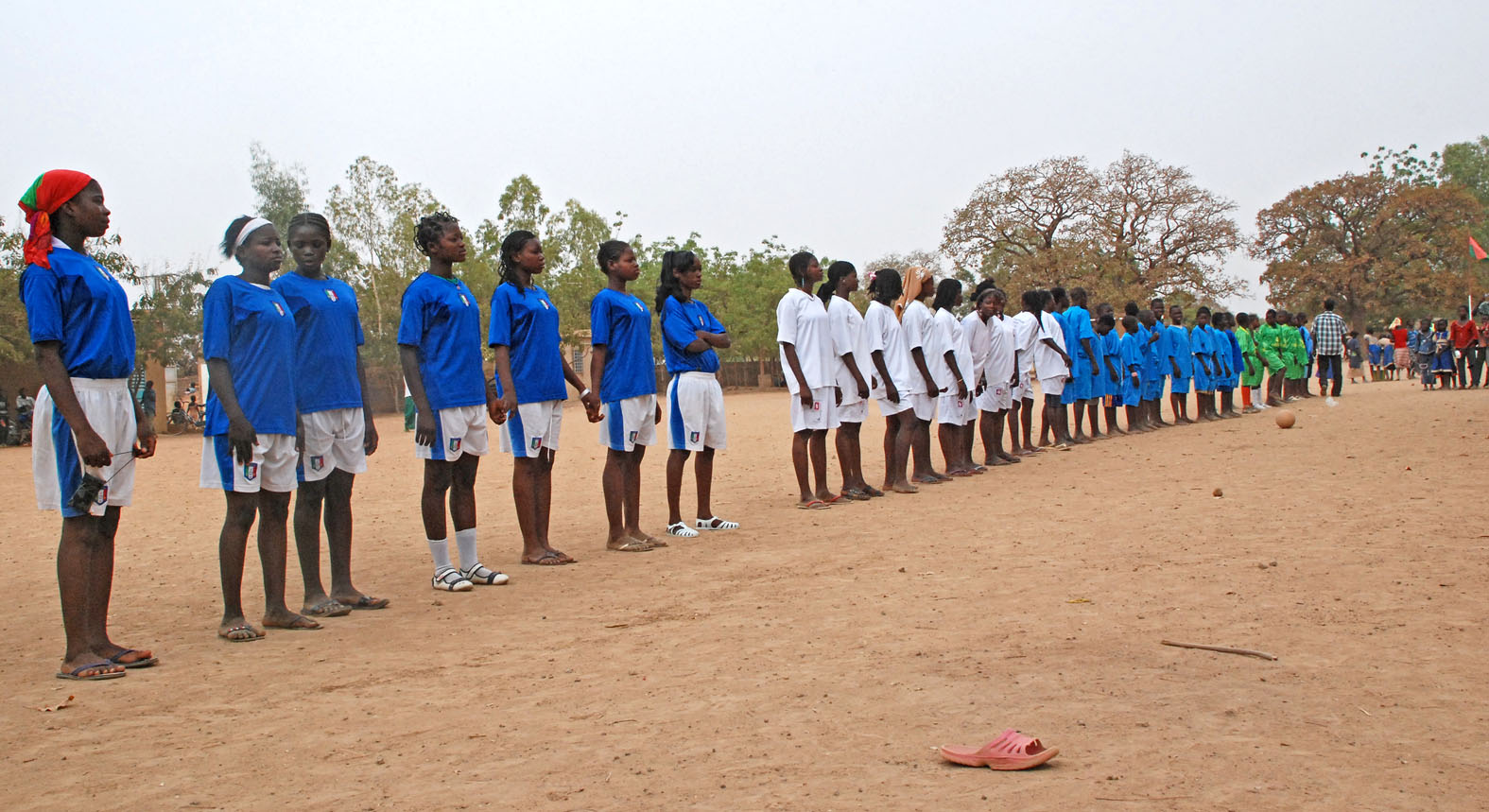
(c) Walter Korn
Cameroon is the home of more than two hundred different ethnic groups. The Bamiléké live in the north and centre and are the biggest tribe in Cameroon. They are known for being efficient business men and dealers. The Haussa and the Fulbe are cattle breeding, nomadic peoples and can be found in the Sahelian Zone. The Bantu peoples live in the south, and the southern rainforest is the home of the Pygmies; the forest wanderers.
Cameroon’s population is almost evenly divided between urban and rural dwellers. Because of the huge number of peoples in the different areas of Cameroon, many different traditions are cherished and maintained. The French speaking part of Cameroon enjoy the flair of the colourful, jovial West-Africa, while the English speaking part is more traditional and subdued. Pidgin English is spoken on the streets and in the pubs in the towns. The teenagers have their own slang which is a wild mixture of English, French, pidgin and African.
Religion
In Cameroon, half the people are Christian and around a quarter Islamic. As in most African countries, the African peoples maintain their own religions and beliefs.
Schools and Higher Education
Although it is compulsory to attend school in Cameroon, around a quarter of the people are illiterate. That doesn’t mean that the people aren’t clever. Quite the opposite, the forest peoples know a great deal about nature, plants and animals that we wouldn’t learn. If the children of the Pygmies attended western Schools, a part of this important knowledge would be sacrificed. Cameroon’s higher education has been a success since independence, with thousands of its graduates mostly consumed by the national public service. There are public universities at Yaoundé, Dschang, Ngaoundéré, Douala and Buéa. The most prominent is the University of Yaoundé, established in 1962. The École Normale Supérieure of University of Yaoundé I is the leading school for teacher education. Many private institutions offer tertiary education. Professional institutes include the School of Administration and Magistracy, the School of Agriculture (ENSA), the Military Academy (EMIA) and the School of Education (ENS). The University of Buea is the only Anglophone style university in Cameroon. Many private institutions offer tertiary education. 40 percent of the female students enrole in tertiary education.
Cameroons Economy

(c) NataPics
Half of the Cameroonians live of agriculture and fishing. Most agriculture is done by local farmers using simple tools. They sell their surplus produce, and some maintain separate fields for commercial use. They cultivate bananas, jams, maniok, cocoa, oil palms, rubber, and tea. On the South Cameroon Plateau, cash crops include coffee, sugar, and tobacco. Forestry and arboriculture contribute a lot to the revenues of Cameroon. But the export of timber and other noble woods has destroyed many tropical forests. The main natural resoures are crude oil, bauxite and natural gas. Not so much of the natural resources are processed in the country. However, cell phone networks and Internet providers have increased dramatically.
Transportation
International airports are located in Douala and Yaoundé. Transport is a problem in Cameroon. Some toll roads connect the main cities, but most of the roads are poorley maintained and subject to the enclement weather. The Intercity bus services are the most popular means of transportation followed by the rail service Camrail.
Plants and Animals
 Big and small mammals, reptiles and insects have survived in the tropical forest region of Cameroon. There are many rarely seen antelope breeds, such as the Common Eland Antelope. In Cameroon there are also many breeds of ape. Because of its lush rainforests, Cameroon offers habitat to many birds and amphibians. The dangerous King Cobra snake lives in the forest and many types of chameleon are also inhabitants. Hundreds of species of fish live in the rivers and lakes and by the coast of Cameroon. In the savannas and forests there is the biggest assortment of butterflies in the world.
Big and small mammals, reptiles and insects have survived in the tropical forest region of Cameroon. There are many rarely seen antelope breeds, such as the Common Eland Antelope. In Cameroon there are also many breeds of ape. Because of its lush rainforests, Cameroon offers habitat to many birds and amphibians. The dangerous King Cobra snake lives in the forest and many types of chameleon are also inhabitants. Hundreds of species of fish live in the rivers and lakes and by the coast of Cameroon. In the savannas and forests there is the biggest assortment of butterflies in the world.
The Takamanda National Park was built along the border of Cameroon and Nigeria and acts to protect endangered gorillas.
History
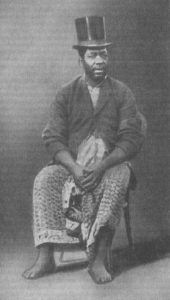 Archeological findings in the grasslands in north and west Cameroon show that the area has been inhabited for millions of years. The traces of ironworking prove that it was here where the Bantu peoples originated. The photo to the left shows King Bell from Cameroon.
Archeological findings in the grasslands in north and west Cameroon show that the area has been inhabited for millions of years. The traces of ironworking prove that it was here where the Bantu peoples originated. The photo to the left shows King Bell from Cameroon.
The European influence began with Portuguese sailors in the 16th Century, when the trade of ivory and sugar cane flourished. The people of Cameroon were barely involved in the Slave Trade. At the beginning of the 19th Century, the Duala Kings and Great Britain signed international treaties for the global prohibition of human trafficking.
The colonial interests of the German, French and English are a big part of Cameroon’s history. In 1868 a Hamburg-based trading house built an establishment at the mouth of the River Wuri. Protection Contracts with the Duala Chiefs were concluded, and soon afterwards Cameroon was declared as a German colony. Little by little, German settlers and traders conquered the outback. Tropical timbers and coffee were coveted exports.
After the First World War, Cameroon was taken into possession by the League of Nations. The League of Nations entrusted Great Britain and France with administration, the aim being that they would govern their areas themselves. For Cameroon to become independent, its people had to fight a lot against the European colonies.
On the 1st January 1960, the French Cameroon declared independence and called itself East Cameroon. The southern region declared independence on 1st October 1961. This separation is the reason why there are two official languages of Cameroon: French and English.
The former colonial powers were still trying to make their influences felt, but the descendants of former African rulers decided to direct the fortunes of Cameroon in accordance with their own ideas and beliefs. As in the neighbouring country of Nigeria, they formed a ruling dictatorship. Despite some reforms, there still isn’t a real democracy in Cameroon. The current government promised a fair distribution of wealth, social justice and freedom of press, but these promises are still waiting to be honoured.
Festivals and Celebrations
The State in Central Africa celebrates its national holiday annually on 20th May. The best part of the festival is a parade in Jaounde.
The Christian festivals such as Easter, Whitsun and the Feast of Corpus Christi are also celebrated. On the 31st October, the Protestants celebrate Reformation Day; Halloween is also celebrated on this day.
The Islamic holidays are celebrated in the north of the country. During the fasting months of Ramadan, Muslims don’t eat throughout the day but after the sun has set. Because of this, many restaurants only open in the evenings. The festivals Eid al-Adha and Eid-al-Fitre last from 2-10 days in every region. The gloriously colourful Bamoun festival takes place annually in the Bamileke region.
Cameroon Today
Since independence Cameroon has faced many political changes. Cameroon has strived for democracy. The state of Cameroon remains with a relative healthy economy, but most of the people have a very low income. And also there are a lot of social problems. Is Cameroon a democray today? Not really. The country is ruled by a president, who controls the nation since many years and suppresses the freedoms of opposition groups. There is not really freedom of press, the press is beholden to special interests and political groups. The radio stations are state-run and the newspapers, which are privately run practice self-censor to avoid government reprisals. The good thing about Cameroon’s government is that it has improved the primary school system. Most of the children go to school. Indeed Cameroon has one of the highest school attendance rates in Africa. But many children are working to contribute to the income of their families. Half of the pupils aged 7 to 14 combine work and school. Cameroon is a young nation, half of the population is 15 years old and younger. Some are organized in pro-democracy movements. Hopefully they will make the change for the better.
Literature from Cameroon
In Cameroon many stories are told about forest spirits and the animals that live in the jungle, such as the shy elephants, snakes and birds. Some authors from Cameroon tell tales from their childhoods.
As in many countries in southern Africa, literature began in the European sense (written down and published) with colonisation. Authors were inspired by ideas of Europe and America. Narratives and novels were written in English or French and some were even translated into German. Most novels are written about the history of Africa. The colonial period plays a big role in the stories, but also the time following, when the African people were caught between traditional life and European influence and had to find their own path. For authors such as Francis Bebey and Mongo Beti, the impulse to write stories stemmed from the desire to preserve their culture and to report about the contradictions between the ideas of tradition and modern.
Francis Bebey is an internationally renowned author and musician, whose partly autobiographical story Rainchild captured Cameroon in the fifties.
More at ‘Stories from traditional Africa’
Mongo Beti has written funny, sharp and critical books about the time during and after colonisation. In his novel The poor Christ from Bomba (La pauvre Christ de Bomba), he criticises the behaviour of the European missionaries. The book caused such furore, that the Catholic Church in France had the novel banned.
Patrice Nganang wrote a book about the present day Cameroon called Hundezeiten (The Times of a Dog). A dog goes on a journey and roams the slums of Jaounde and experiences the different sides of life in an African city with its many dangers, pleasures and absurdities.
Mireille Makampé offers an insight into the lives of women in Cameroon in her book My Father’s Will be Done (Lübbe 2002). She describes how African women protest against old traditions and find their own path between African and western lifestyles.
André Ekama writes about the questions about Africa that everybody asks: “How can it be, that the people of Obramkuza can only dream of prosperity and development, when the persistent promotion of its rich mineral resources must bring such a great profit?
The thirteen stories from his book The Treasures from Obramkuza answer these questions from very different points of view. (Monsenstein und Vannerdat 2009)

